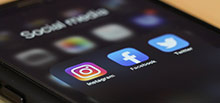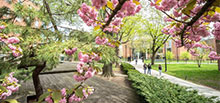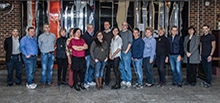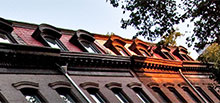Drawing on Your Inner Canvas
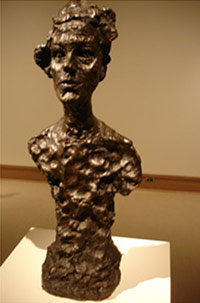
Alberto Giacometti, 'Annette'
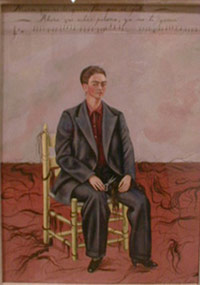
Frida Kahlo, 'Self-Portrait with Cropped Hair'
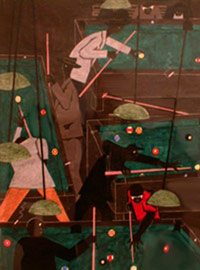
Jacob Lawrence, 'Pool Players'
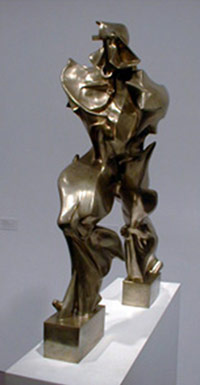
Umberto Giacometti, 'Unique Forms of Continuity in Space'
Presenter
John Toth, Hunter College
Session / Time
- Breakout Session II
- Thursday, April 26, 1:15 - 2:30 p.m.
- Bedford Room
Description
Line of Inquiry
How do Kahlo, Giacometti and Lawrence use body language and facial expression to communicate emotion, ideas and symbolic meaning?
Pedagogical Inquiry
- How does non-verbal communication add value to communication?
- What are the limits of written and spoken language?
- How do multiple intelligences address the limits of language?
Objective
Explore ways in which body gestures, hand gestures, facial gestures can assist in verbal story telling. Explore gestures that occur in everyday tasks. Explore gestures that exaggerate add some to a personal story.
Content
Body language and facial expression is the use of non-verbal communication using head, facial features, hands and arms, torso and legs to imply meaning.
Goals
- To explore gesture as a form or movement of a body or body part that communicates or emphasizes an idea or purpose.
- To visualizing and utilize body language is a means of non-verbal communication.
- To visualize hand and body gestures as communicating the content of mind and emotions.
- You can also differentiate between interior attitudes vs. exterior attitudes.
Skill Activity - Gesture Drawing
- Butterfly Sketches: Students will take turns modally their bodies into poses that communicate a variety of contents, emotions, tasks and human expressions.
- Zig-Zag Sketches: Make zigzag sketches of small groups of posing individuals.
- Picasso Sketches: make draws using only circle, square, triangles and lines.
Creative Activities
Wire Activity
- Make a list of the "qualities of the relationships" that were discussed in the artworks. (Longing, yearning, grasping, confused, thinking)
- Work in pairs to recreate the poses we saw in the sculptures and paintings from the Met. First person makes a gesture based on the qualities from the list; the second person responds with a gesture.
- Both students make a wire representation of their own gesture. Combine wire sculptures in a meaningful way.
Clay Activity
- First make a portrait, without looking. (Explore intuition). Next, use clay to make a sculpture that represents your pose. (Heading towards a goal)
- Or make gesture drawings using sketchy lines (stick figures) to recreate poses using body language to communicate a variety of expressions and ideas.
Kinesthetic Activity
- Look at posters of artworks that explore relationships. Use only your arms to transform the mood or content of each work.
- Describe the different kinds of relationships you have at:
- school?
- home?
- the street?
- nature?
- our dreams?
- Explore "open" and "closed" body language to communicate the meaning of a relationship from the above list.
Reflection Questions
- What did you learn about how you create?
- Here is a list of questions that will focus attention on the ‘what’ and ‘how’ of interpreting facial expression and body language.
- What does the facial expression suggest?
- How do the shapes of eyes and eyebrows change with emotions?
- Can you describe the shapes of eyes using in geometric and metaphoric terms?
- What does the gesture of the hands suggest?
- What does posture suggest?
- How does the person stand?
- If this person could speak, what do you think they would say?
Goals / Content / Intentionality
- To explore gesture as a form or movement of a body or body part that communicates or emphasizes an idea or purpose.
- To visualizing and utilize body language is a means of non-verbal communication.
- To visualize hand and body gestures as communicating the content of mind and emotions.
- You can also differentiate between interior attitudes vs. exterior attitudes.
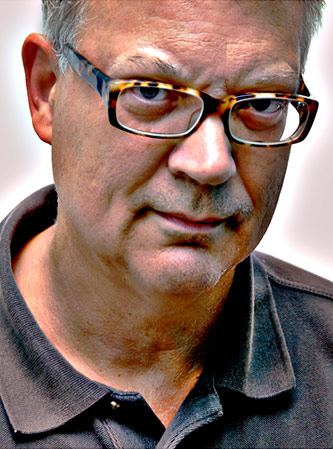
John Toth, Hunter College
Presenter Bio
John Toth, Hunter College
John Toth is an intermedia artist who has a 45-year history of art collaborations with composers/musicians, choreographers/dancers, directors/actors, writers/poets and teachers that began in Buffalo, NY where he received a Masters degree in Art.
John’s gained a national reputation for projecting multiple videos into his large-scale fabric installations that began in 1980 in collaboration with John Cage and Lejaren Hiller’s production of HRPSCHD presented at The Albright-Knox Art Gallery. John’s ongoing commitment and support to the Western New York art scene includes shows at The Albright-Knox Art Gallery, the Burchfield Penney Art Center, Hallwalls, Artpark, and Buscaglia-Castellani Art Museum.
In 1985 John moved to New York City and furthered his art collaborations that were shown at The Brooklyn Museum of Art, the Lincoln Center "Out-Of-Doors Festival," The New Museum, Experimental Intermedia Foundation, Cork Gallery, The Camera Club Gallery, 78th Street Theater Lab, Access Theater, City Gallery, C.B.G.B.’s, SOHO Photo Gallery and Audart Gallery.
John has also established an international reputation through his intermedia fabric installations that have been presented at The National Museum of Photography, Film and Television in Bradford, England; Ringacker Hall in Saas-Fee, Switzerland; Fundacion para el Arte Contemporaneo, Mexico City; and “A” Space, Toronto, Ontario.
John’s philosophy for art making is about transformation of places. “My installation artworks have always been about creating and transforming ‘places into spaces’. My fabric installations seek to transform hard edge architectural places into ethereal spaces for viewers to have an aesthetic experience through the presentation of light and video.”
John has also made a lifetime commitment to teaching. He received a Ph.D. in Media and Communications at the European Graduate School in Leuk Stadt, Switzerland in 2005. He has been teaching The Arts at Hunter College in Manhattan since 2004. He has worked extensively as a teaching artist for Lincoln Center Institute, The Juilliard School, Symphony Space, Bank Street College, Bard College, Lehman College. John has also led teacher training workshops around the United States that include The Harweldon Institute, The Memphis Art Institute, Young Audiences.
John’s publishing record includes peer-reviewed articles that include: The virtual teaching artist: strategies for a museum podcast (published in the Teaching Artist Journal in 2011), The New Perception: Hypermediating Interdisciplinary Cultures Through Aesthetic Education (published in the Forum on Public Policy Online: A Forum of the Oxford Roundtable in 2008). John has also presented papers to the American Education Research Association in San Diego on "Seeking a Common Language Between Arts and Education" and on "Tools, Skills and Practice," using questions as a tool.


